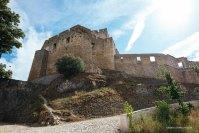
The first thing you pass on your journey to the Templar city of Tomár, 60 kilometres east of Batalha, is the impressively arched stonework of an aqueduct (Aqueduto dos Pegões) tracing the contours of the rolling green landscape in Centro de Portugal’s Oeste subregion, carrying water, over 6 kilometres, to within the walls of the city’s historic Convento de Cristo. The bullish stonework of the Convent of the Knights of Christ stands atop a hill overlooking the peaceful tranquillity of the city of Tomár and the flat waters of the River Nabão reflecting a perfectly blue sky.
In the town’s main square (Praça de Republica) where people go about their daily lives (and occasionally dance), stands a statue of a man to whom the town owes its beginnings; Gualdim de Pais, the fourth Grand Master of the Knights Templar. In 1159, after the retaking of the region from the Moors by the Portuguese Kings, the lands of Tomár were granted to the Order of the Knights Templar under the leadership of Gualdim de Pais. Their role was to protect the lands from Moorish attacks and any attempts at reconquest. One such repelled attack came in 1190 when the Moroccan leader, Yusuf al-Mansur was defeated by Gualdim de Pais and his Templar Monk Knights. A plaque still stands on the site of the battle commemorating the famous victory.
Tomar in Centro de Portugal
Entry to the Convento de Cristo and the Templar castle is through the narrow gates of a highly fortified and solidly constructed outer wall. However, once inside, the beauty of the convent and its chapels lie in direct contrast to the functionality of the citadel’s outer appearance – most especially the unique Templar Charola (Rotunda) so typical of the military religious Templars. At the time of its construction, – beginning in 1160 – the fortress was one of the grandest fortified schemes ever attempted on Portuguese soil. The Templars at this time were highly respected as was the reputation of its founder, Gualdim de Pais. However, that was about to change.
Under the rule of Pope Clement V, the Catholic church wanted to ban the Order of the Knights Templar right across Europe and the Middle East. However, King Dinis persuaded the pontiff to seamlessly transfer the powers of the Order to the newly established Order of Christ – in effect, the same Order under a different name. The headquarters of the newly formed Order of Christ moved several times but in 1356 returned to Tomár where it remained in control of the Order’s affair for the following centuries. One leader of the Order of Christ was none other than the famed Henry the Navigator who used the Order and its resources to further expand the Portuguese empire and its fortunes across the world’s oceans. Henry was also responsible for the present day look and layout of the city of Tomar in Centro de Portugal.
Inside the walls of the citadel there is much to explore; the Cemetery Cloister, the Laundry Cloister, the Manueline interior of the main church, the King Joao III Cloister, the convent’s dormitories and refectory and so much more dating from the fortress/convent’s original inception through each age of reconstruction and refurbishment.
But the city of Tomar in Centro de Portugal is more than the sum of its Templar history. Every four years, in early July (next one in 2019), the city enjoys one of Portugal’s most loved and well-know festivals; Festa Dos Tabuleiros (the festival of trays – named after the trays of bread carried on the heads of the parade-goers) or the Festa do Divino Espírito Santo (festival of the Holy Spirit). The festival has its roots set back in the 13th century it has become popularised as a major tourist attraction over the past fifty years drawing crowds from around the world. Tomár also celebrates its Templar history and associations through a series of events including, the torch-lit parade of Knights Templar, medieval banquets and the restaging of a battle on the Templar castle between Knights and Moors.
Tomar in Centro de Portugal is also has a long and very proud history of Judaism, the city being home to an established Jewish community since at least the early 14th century. However, in 1496 King D. Manuel issued an edict just under a year to convert to Christianity or leave the country. Some accepted the King’s edict, but continued to practice their religion secretly as ‘crypto-Jews’ (hidden Jews) or Marranos, many others fled the country avoiding persecution. Today the Jewish community’s synagogue – acquired by one Samuel Schwartz in 1923 – has been restored and is open to the public as the Jewish Museum Abraão Zacuto attracting visitors from across the world.
Tomar in Centro de Portugal is undoubtedly a city with strong links forged to its Templar past, but along with these historic connotations, and as a place of significant cultural importance, Tomár is a pleasant town, best taken in bright sunshine and a wanderly stroll through its ancient streets and along the banks of the peacefully flowing River Nabão. If you listen carefully you may still hear the voices of its founders echoing on the light breeze which ruffle the leaves of the overhanging willow trees.
This Tomar in Centro de Portugal post is a part of a series of 9 posts I wrote based on my journey to the Oeste Region in July 2016. Please find the links o the other articles bellow:
Peniche in Centro de Portugal
Berlengas Islands in Centro de Portugal
Nazaré in Centro de Portugal
Obidos in Centro de Portugal
Batalha Monastery in Centro de Portugal
Alcobaça Monastery in Centro de Portugal
AdegaMãe Winery
Areias do Seixo Hotel
Disclaimer:
This Alcobaça Monastery in Centro de Portugal post was written by my inspiring friend Br
